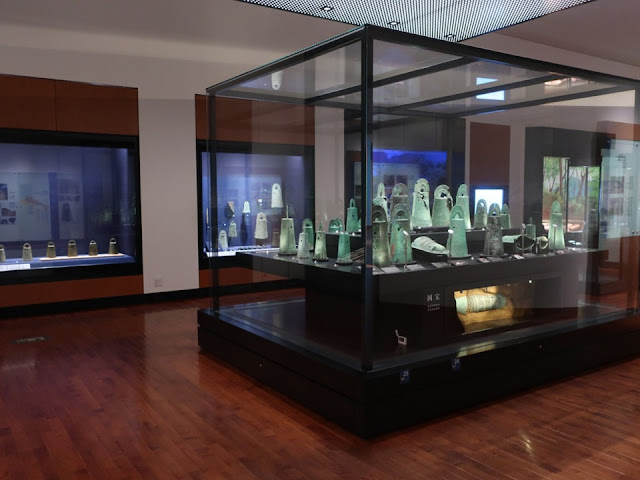Part1 of this article: Shimane Museum of Ancient Izumo (1/2)、古代出雲歴史博物館 part1 Izumo Shrine and its legends
Life in ancient Izumo (Izumo Fudoki)、出雲国風土記の世界
Izumo Fudoki was issued in the 8th century and was submitted to the emperor (Tennoh); it recorded the culture and geography of Izumo province. The exhibits recreate daily life back then.
出雲は、大和朝廷が諸国の様相を記録した風土記が残る5カ国のうちの一つです。古代の出雲、神々の話、人々の話が記されています。風土記を基に、古代の人々の生活が模型で紹介されています。
The model in front is Ohi Beach, and the market is displayed in behind. Seafoods and vegetables are sold.
手前が松江にあった大井浜の模型、奥は市の実物模型です。海産物や野菜が取売られていました。
The Fudoki told us resorts such as onsen (hot-spring) and mountains. People gathered at various spots; it’s same as the present lifestyle.
風土記には温泉や山などの行楽地も記されています。玉造温泉には老若男女が集まって楽しんでいました。今と変わりません。
The model shows an ancient party (utagaki/kagai) is exhibited. Ancient people often acted as a group; young men and women went to party and picnic to find partners. Some seniors taught young people the know-how. It’s pleasant.
歌垣も展示されています。古代は集団で行動することが多く、適齢期の男女は歌垣や野遊びに出かけパートナーを探しました。手ほどきをしてくれる年長者もいたと書かれています。宴の模型があります。微笑ましい。
A Japanese harp and a handy drum were recreated, which people probably used at the party or the festival.
古代の琴や鼓(細腰鼓/さいようこ)が復元されています。これらを奏でて楽しんだり、祭りをしていたのでしょう。
Plenty of bronze ware such as bell-shaped vessels are exhibited. All ancient exhibits are worth visiting. However, I chased lives of ordinary people.
青銅器などの古代の展示はたいへん充実していますが、本ブログのテーマである人々の暮しに関する展示を追っていきます。
History of Shimane (Izumo region at present)、島根の人々の生活と交流
Izumo was the largest production province of jewels (sphere) in the ancient era. The model of a jewel workshop is interesting.
出雲は弥生時代から玉作りが盛んで、古墳時代後期からは全国最大規模の生産地でした。遺跡も残っています。作る人の模型も興味深いです。
Traditional iron manufacturing is exhibited. It had also been an industrial area. I think workers suffered from hard work. I wonder whether they had a fun time or not.
石見銀山とともに、たたら製鉄も紹介されています。鉱工業地域ですね。でも、労働集約型で管理も厳しそうだし、たいへんな苦労だったと思います。彼らにも楽しみはあったのでしょうか。
There have been worshipers of Jodo Shinshu which has been a major Buddhism sect in Japan in Izumo. They created Buddhist sermons. Saichi (1850-1932) on the left was a shoemaker who created lots of sermons. Even an ordinary person was a great influencer. His statue in Yunotsu (Tomokan @ Tomogaura and Yunotsu in Shimane) has horns on his head.
浄土真宗の信仰が厚い妙好人(にん)という人たちが多く、法語を残しています。左側の才一(1850-1932)は温泉地・温泉津(ゆのつ)の下駄職人でしたが多くの歌(口あい)を残しました。市井の人もインフルエンサーでした。左は温泉津にある角を生やした才一の像です(鞆館(鞆ヶ浦)と温泉津)。
Old photos are displayed in the modern section. The photo above shows a pilgrimage in Izumo, which was popular among locals. It’s a mixed group of men and women. I’m sure they had a fun time.
「小泉八雲(1850-1904)が語る島根」のパネルに昔の写真が掲載されています。こちらは「出雲巡礼の様子(日本地理風俗体系10巻より)」です。出雲国内の巡礼は盛んだったそうですが、老若男女混成のツアーですね。間違いなく楽しい時間だったと思います。
It is “Pilgrimage route of Izumo” (Matsue History Museum). I admire them because they could travel with the simple map. It was issued in 1817.
松江歴史館に展示されている「出雲札三十三所道法附絵図」。この地図で旅行するのですから驚きます。文化14年(1817年)と書かれています。
Armature sumo wrestlers gathered at the stadium in the early 20th century. They were full of energy, but were a bit nervous. Two of them had a good looking mawasi (decorated loincloth).
「20世紀初めの相撲の様子(個人蔵)」は、ちょっと緊張した面持ちですが、立派な化粧まわしを着けた力士もいます。後ろに観客席が写っています。
The old photos show us the difference of lifestyle between in the past and at present. Ladies carried a baby on her back while working. And, animals also worked.
明治から現代に至る島根の人々の生活の変化を紹介するパネルがありました。子守をしながら働くこと、働く動物がいることが今との違いですね。
So many people visited a festival; it is also a difference.
祭りに集まる人が多い。
We were not so rich back then, however, everyone seemed to be happy. It’s important to have a fun time.
今より貧しく不便な時代でしたが、みなさん、幸せそうです。遊べるということは大切ですね。
The huge museum also has a myth exhibition room, because there are many well-known myths in Izumo. A rabbit appears in mythology and its statue is in the garden. I think we prioritize on an adorable thing too much.
巨大な博物館です。紹介しませんでしたが、神話展示コーナー(部屋)もあります。そして、庭には兎が勾玉にキスしている像があります。可愛いを大切にする文化になってきましたね。
There is a priest residence district next to Izumo Shrine and the museum. It exuded a dignified atmosphere.
出雲大社社殿と博物館の隣の社家町(神官が暮らす町)は、厳かな雰囲気です。
Visited in November, 2022
Official website: https://www.izm.ed.jp/english/index.html
https://www.izm.ed.jp/
(written in Japanese, but lots of info), accessed in April, 2023
Previous post (Izumo Shrine and its legends):
Shimane Museum of Ancient Izumo (1/2)、古代出雲歴史博物館 part1
Next post (museum in the castle city of the same prefecture): Matsue History Museum、松江歴史館

















Comments
Post a Comment